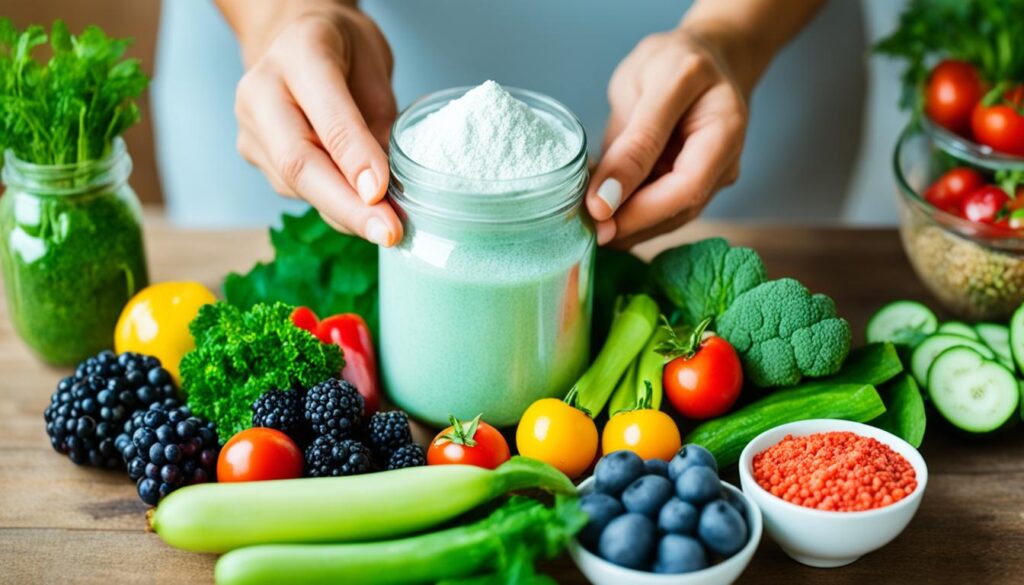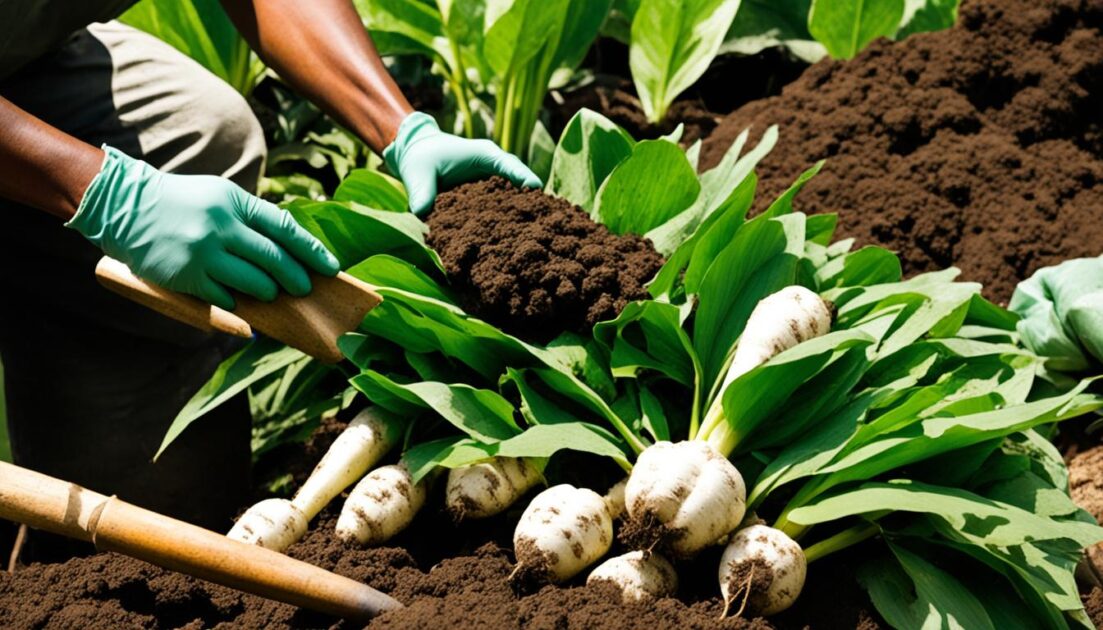Are you looking for a gluten-free and natural alternative to thicken your sauces or bake your favorite treats? Look no further! In this easy DIY guide, I will show you how to make homemade arrowroot powder, a versatile ingredient that can elevate your gluten-free cooking and natural care routine.
Making arrowroot powder at home may require some effort, but the end result is definitely worth it. By following a few simple steps, you can create your own pure white powder that can be used as a thickening agent and a gluten-free flour substitute.
Key Takeaways:
- Homemade arrowroot powder is a gluten-free and natural alternative for thickening sauces and baking.
- It is obtained through a process of cleaning, chopping, grinding, and filtering the arrowroot root.
- Arrowroot powder offers various health benefits, including promoting weight loss, treating diarrhea, and boosting the immune system.
- Arrowroot powder can be used in a wide range of recipes, from gravies and soups to puddings and homemade deodorant powder.
- If you don’t have arrowroot powder available, you can use cornstarch or tapioca starch as substitutes.
Arrowroot Powder Recipe
Creating your own arrowroot powder at home is a rewarding and cost-effective alternative to store-bought options. Follow this simple recipe to make your very own homemade arrowroot powder.

- Start by cleaning the outer skin of the arrowroot thoroughly, ensuring all dirt and impurities are removed.
- Trim the edges of the arrowroot to ensure a clean and fresh start.
- Chop the arrowroot into small pieces for easier grinding.
- Grind the arrowroot pieces in batches, adding water to aid in the process.
- Using a strainer, filter the mixture to separate the liquid from the thick substance. Repeat this process multiple times until the water on top is clear.
- Ensure all the excess water is extracted, and then proceed to dry the thick substance under direct sunlight for at least a day.
- Once the moisture is completely gone, grind the substance into a fine powder.
- Sieve the powder to remove any coarse particles, ensuring a smooth and refined texture.
- Store your homemade arrowroot powder in an airtight container for future use.
By following this simple recipe, you can enjoy the benefits of homemade arrowroot powder in your cooking and baking endeavors.
Arrowroot Powder Uses
Arrowroot powder is a versatile ingredient with a wide range of uses in cooking and baking. Whether you’re looking to thicken sauces, create gluten-free recipes, or even make homemade personal care products, arrowroot powder can be a valuable addition to your pantry.
Thickening Agent
One of the primary uses of arrowroot powder is as a thickening agent. Its fine texture allows it to dissolve easily into liquids without clumping, making it ideal for thickening sauces, gravies, and soups. Simply mix a small amount of arrowroot powder with cold water to create a slurry, then add it to your hot liquid, stirring constantly until thickened.
Gluten-Free and Paleo Baking
If you’re following a gluten-free or Paleo diet, arrowroot powder can be a fantastic substitute for wheat flour. Due to its high starch content, arrowroot powder can mimic the texture and binding properties of regular flour without the gluten. Use it in your favorite baking recipes, such as cookies, cakes, and bread, as a one-to-one replacement for wheat flour.
Puddings, Custards, and More
Arrowroot powder is commonly used to create smooth and creamy desserts like puddings and custards. Its ability to thicken without adding a starchy taste makes it perfect for these sweet treats. Simply incorporate arrowroot powder into your recipe, heat the mixture until it thickens, and allow it to set before serving.
Homemade Deodorant Powder
An interesting and unconventional use for arrowroot powder is as a key ingredient in homemade deodorant powder. Due to its absorbent properties, arrowroot powder can help absorb moisture and keep you feeling fresh throughout the day. Mix arrowroot powder with other natural ingredients such as baking soda, essential oils, and coconut oil to create your own customized deodorant powder.
Natural Alternative to Talcum Powder
For those looking for a natural alternative to talcum powder, arrowroot powder can be a great option. Its absorbent and silky texture makes it ideal for preventing chafing and keeping skin dry. Whether you’re dealing with diaper rash or want a natural body powder, arrowroot powder can provide a gentle and effective solution.
Binding Agent in Gluten-Free Recipes
Arrowroot powder can also serve as a binding agent in gluten-free bread and cookie recipes. Its starchy nature helps provide structure and prevent crumbling in baked goods that lack gluten. Whether you’re making gluten-free biscuits or cookies, adding arrowroot powder to your recipe can help improve texture and hold your baked treats together.
With its numerous uses and versatile properties, arrowroot powder is a must-have ingredient for any kitchen. Whether you’re thickening sauces, baking gluten-free goods, or experimenting with homemade personal care products, arrowroot powder can elevate your culinary creations and provide a natural alternative.

Arrowroot Processing and Cultivation
Arrowroot processing involves several steps to transform the root into the fine powder used in various culinary applications. Let’s take a closer look at the process of arrowroot processing and cultivation.
Processing Arrowroot
To begin the processing of arrowroot, the outer scales of the root are peeled away, revealing the starchy core. The root is then carefully washed to remove any dirt or impurities.
“Careful cleaning of the arrowroot root is essential to ensure a pure and high-quality end product.”
Once cleaned, the arrowroot root is smashed with a meat pounder or a similar tool to break it down into smaller pieces. This step helps to release the starch present in the root.
“Smashing the arrowroot root helps to extract the starch, which is an integral part of arrowroot processing.”
The smashed arrowroot pieces are then submerged in water. As arrowroot starch is not water-soluble, it settles at the bottom of the water while the impurities float to the top.
“The settling of the arrowroot starch at the bottom allows for the separation of the pure starch from the water.”
After pouring off the water, the arrowroot starch is spread out in the sun to dry. The sun’s heat helps to evaporate the remaining moisture content in the starch, leaving behind a fine powder.
“Drying the arrowroot starch under the sun is a crucial step to obtain the desired consistency and quality of the arrowroot powder.”
Arrowroot Cultivation
Arrowroot is primarily cultivated in certain regions worldwide, including Kerala, India. The ideal season for arrowroot cultivation in Kerala is the thiruvathira season, as the climate and soil conditions are conducive to the growth of arrowroot.
“The thiruvathira season in Kerala provides the perfect environment for the cultivation of arrowroot crops.”
The cultivation process involves planting arrowroot rhizomes, which are the underground stems of the arrowroot plant. The rhizomes are carefully placed in the soil, ensuring adequate spacing for proper growth.
“Proper spacing between each arrowroot rhizome promotes healthy growth and allows for better utilization of nutrients.”
Arrowroot plants require consistent watering and a nutrient-rich soil to thrive. It takes approximately 8 to 10 months for the arrowroot plants to reach maturity.
“Providing the arrowroot plants with the right amount of water and nutrients is crucial for their growth and development.”
Once the arrowroot plants have matured, the rhizomes are carefully harvested from the soil. These rhizomes serve as the raw material for arrowroot processing.
“The harvested arrowroot rhizomes undergo processing to extract the starch and create the arrowroot powder.”
Summary of Arrowroot Processing and Cultivation
In summary, arrowroot processing involves cleaning, smashing, washing, drying, and grinding the arrowroot root to obtain a pure and high-quality arrowroot powder. The cultivation of arrowroot requires a suitable climate, nutrient-rich soil, and careful farming practices. Together, the processing and cultivation of arrowroot contribute to the production of this versatile and nutritious ingredient.
| Processing | Cultivation |
|---|---|
| – Peel outer scales | – Select ideal season for cultivation |
| – Wash and clean thoroughly | – Plant arrowroot rhizomes |
| – Smash root to release starch | – Provide consistent watering and nutrients |
| – Submerge in water for starch separation | – Harvest mature arrowroot plants |
| – Dry starch under the sun | |
| – Grind into a fine powder |
Now that we understand the intricacies of arrowroot processing and cultivation, we can appreciate the effort and skill involved in producing this valuable ingredient.

Arrowroot Benefits
Arrowroot is packed with beneficial properties that make it a valuable addition to a healthy diet. Here are some of the key benefits of arrowroot:
- Promotes Weight Loss: With its low-calorie content and high fiber, arrowroot can help support weight loss goals. It promotes satiety, preventing overeating, and aids in digestion.
- Treats Diarrhea: Arrowroot powder possesses soothing properties that can help alleviate diarrhea, especially in children. Its gentle nature makes it an ideal remedy for easing digestive discomfort.
- Boosts the Immune System: Consuming arrowroot can help strengthen the immune system, thanks to its immune-boosting properties. It supports overall health and well-being.
- Improves Digestion: Arrowroot powder is known to have digestive benefits. It aids in the breakdown and absorption of nutrients, aiding in optimal digestion.
- Gluten-Free Option: For individuals with celiac disease or gluten sensitivity, arrowroot serves as an excellent gluten-free alternative. It can be used in various recipes without compromising taste or texture.
Comparison of Arrowroot Benefits
| Benefits | Arrowroot | Other Starches |
|---|---|---|
| Promotes Weight Loss | ✅ | ✅ |
| Treats Diarrhea | ✅ | ❌ |
| Boosts the Immune System | ✅ | ✅ |
| Improves Digestion | ✅ | ✅ |
| Gluten-Free Option | ✅ | ✅ |
As the table above indicates, arrowroot stands out in terms of its ability to treat diarrhea, making it an excellent choice for those seeking relief from digestive issues. It also offers comparable benefits to other starches, such as weight loss promotion, immune system support, improved digestion, and gluten-free options.
With its numerous benefits, incorporating arrowroot into your diet can contribute to overall well-being and enhance your culinary endeavors.
Arrowroot Powder Substitute
If you don’t have arrowroot powder on hand, there are alternatives that can be used as substitutes. Cornstarch and tapioca starch are commonly used as substitutes for arrowroot powder in recipes. These starches have similar thickening properties and can be used in a 1:1 ratio. However, keep in mind that the taste and texture may vary slightly when using substitutes.
Cornstarch is derived from corn and is a popular choice for thickening sauces, gravies, and soups. It creates a smooth and glossy texture in the final dish. Tapioca starch, on the other hand, is made from the cassava root and is often used in gluten-free baking. It adds a chewy texture to recipes like pies and puddings.
When substituting arrowroot powder with cornstarch or tapioca starch, it is important to note that the thickening power may differ slightly. You may need to adjust the amount of substitute used to achieve the desired consistency in your recipe. Additionally, it is always recommended to test the substitute in a small portion of the recipe before using it in larger quantities.
Whether you choose cornstarch or tapioca starch as a substitute for arrowroot powder, both options can help you achieve the desired results in your cooking and baking endeavors. Experiment with these substitutes to create delicious gluten-free dishes and enjoy the benefits of arrowroot powder even when it’s not readily available.
FAQ
How do I make arrowroot powder at home?
To make arrowroot powder at home, start by cleaning the outer skin of the arrowroot and trimming the edges. Chop the arrowroot into pieces and grind them in batches with water. Filter the mixture through a strainer to separate the liquid from the thick substance. Repeat the filtering process multiple times until the water on top is clear. Extract all the water and dry the thick substance under the sun for at least a day. Once the moisture is gone, grind the substance into a fine powder and sieve it before storing.
What are the uses of arrowroot powder?
Arrowroot powder has versatile uses in cooking and baking. It can be used as a thickening agent in sauces, gravies, and soups. It is also a popular ingredient in gluten-free and Paleo recipes as a substitute for wheat flour. Arrowroot powder can be used to make puddings, custards, and even homemade deodorant powder. It absorbs moisture and can be used as a natural alternative to talcum powder. Additionally, arrowroot powder can be used as a binding agent in gluten-free bread and cookie recipes.
How is arrowroot processed and cultivated?
Arrowroot processing involves peeling the outer scales of the arrowroot root and washing it thoroughly. The root is then smashed with a meat pounder and submerged in water. The starch in the arrowroot is not water-soluble and settles at the bottom of the water. After pouring off the water, the arrowroot starch is spread out in the sun to dry. Arrowroot is cultivated in certain regions, such as Kerala, India, where the thiruvathira season is ideal for procuring and preparing arrowroot powder.
What are the benefits of arrowroot powder?
Arrowroot offers various health benefits due to its starch content. It is associated with promoting weight loss, as it is low in calories and high in fiber. Arrowroot powder can also help treat diarrhea, especially in children, due to its soothing properties. It is known to have immune-boosting properties and may help improve digestion. Additionally, arrowroot is gluten-free, making it suitable for individuals with celiac disease or gluten sensitivity.
What can I use as a substitute for arrowroot powder?
If you don’t have arrowroot powder on hand, there are alternatives that can be used as substitutes. Cornstarch and tapioca starch are commonly used as substitutes for arrowroot powder in recipes. These starches have similar thickening properties and can be used in a 1:1 ratio. However, keep in mind that the taste and texture may vary slightly when using substitutes.






